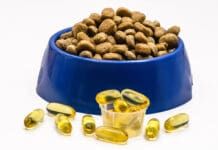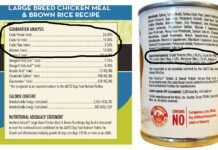Just as snack foods for humans range from nutritious to unhealthy, dog treats vary wildly in quality and nutritional status. What often looks like a delicious reward can undermine your dog’s health over time. This is why choosing healthy dog treats—and knowing how to use them—is one of the most important, yet also frequently overlooked, aspects of canine nutrition. The good ones don’t come cheap, but they’re worth the money.
So, yes, we are picky about our dog treats. We like freeze-dried treats, but we pay attention to the protein used. We want to know what it is!
Our top choices and favorites in dog treats are, by category, are:
Complete-and-balanced freeze-dried
- Instinct Raw Meals
- Vital Essentials freeze-dried raw
- Stella & Chewy’s meal mixers
- K9 Naturals
Single-Ingredient freeze-dried
- Pure Bites (chicken breast, salmon, beef liver)
- Vital Essentials (Chicken breast, minnows, salmon bites, beef liver, chicken hearts)
- Stella & Chewy’s (Chicken heart, beef heart)
Consider Proteins in Dog Treats
When choosing the healthiest dog treats, pay attention to the protein source used. Named proteins, like turkey, duck, lamb, or salmon, are far preferable to ambiguous labels such as meal meals or byproducts. High-quality proteins offer amino acids to help maintain your dog’s muscles, coat, and immune system. Just as important is what is not present in a treat. Avoid ingredients like artificial colors, flavors, and preservatives.
Calories Matter in Dog Treats
Calorie content is crucial in dog treats. Whenever you are giving treats, the amount you are feeding is key. Too much of anything can be harmful, and healthy treats can absolutely be given in unhealthy amounts. Even treats that offer ample health benefits can contribute to weight gain if overfed. Many pet owners are surprised to learn how quickly calories from treats can add up, particularly for small breeds or for dogs with low activity levels.
A general rule of thumb is the amount of treats fed should not exceed 10% of your dog’s daily calorie requirement, else you risk creating imbalances in the diet. For a small dog eating around 400 calories per day, that’s just 40 calories in treats, meaning even a few extras can tip the scale. When looking at treats, consider size and density. While large, dense chews may seem satisfying, they often deliver far more calories than expected. In contrast, small, low-calorie treats allow for more frequent rewards without overfeeding.
Best Treats for Dog Training
For training, small, strong-smelling, and easily consumed treats are essential. Dogs need quick rewards that hold their attention and don’t interrupt the pace of the session. The healthiest versions of these use natural flavorings and keep ingredients minimal while still offering a tempting aroma. For training, you want high-value, tasty dog treats that the dog really wants to work for! When training, soft treats are considered a better choice over crunchy pieces that take longer to chew.
For puppies or dogs undergoing training where I know I will be using a lot of rewards, I use a complete and balanced diet food as treats in the form of kibble or freeze-dried to avoid creating gaps in nutrition.
Best Daily Dog Treats
For casual settings, like daily bonding, walks, or enrichment time, treats can afford to be a little more substantial. Freeze-dried meat treats are a great option, as they are typically made from a single ingredient, such as beef liver, chicken breast, or salmon. These treats are rich in protein, packed with natural flavor, and have the added benefit of being shelf-stable without artificial preservatives, plus they keep pockets relatively clean.
Functional Dog Treats
Functional dog treats bridge the gap between supplements and treats. They aim to go beyond taste to provide a direct health benefit. These may include ingredients designed to support joint health, improve digestion, or enhance skin and coat quality:
- Treats that contain glucosamine and chondroitin can help maintain cartilage in older dogs or breeds prone to joint issues.
- Treats that promote skin and coat health or immune function may contain omega-3 fatty acids from sources like fish oil or flaxseeds.
- Others may include probiotics or prebiotic fibers like inulin to support healthy gut flora, which in turn can improve digestion and gut health.
When choosing functional treats, it’s especially important to research the brand and ensure claims are backed by quality ingredients and research rather than just clever marketing language.
Make Your Own Dog Treats
An often-overlooked option for pet owners is homemade dog treats. Preparing your own treats allows for complete control over the ingredients, which is ideal for dogs with allergies or sensitivities. Simple recipes made from ingredients like peanut butter (without xylitol), pure pumpkin, banana, oats, and eggs can yield soft or crunchy treats that dogs love. Even fruits and vegetables like apples, blueberries, carrots, and green beans can double as a healthy, low-calorie snack. For training, boiled chicken or beef with a trace amount of garlic for a strong aroma is a good option.
Dog Treats Should Fit the Dog
What is important to recognize is that the definition of “best” varies from dog to dog. What works for a high-energy working dog may not suit a couch-loving senior. Age, breed, activity level, and health status all influence the ideal type of treat. For example, a puppy might benefit from a higher calorie, DHA-rich training treat to support brain development, while a senior dog may need low-fat treats that also support joint mobility.
Similarly, a toy breed might need tiny, low-calorie rewards to prevent weight gain, while a large, active dog can enjoy slightly more substantial snacks without issue. Even with high-quality treats, moderation and balance remain key. Over feeding of treats, no matter how healthy, can disrupt the nutritional balance of your dog’s main meals.
Incorporating healthy treats into your dog’s routine is one of the simplest and most effective ways to support their overall well-being while also enhancing the bond you share with your pet. Whether you are rewarding good behavior, reinforcing training, or simply showing affection, choosing treats made with wholesome, natural ingredients ensures that every bite contributes to your dog’s health rather than compromising it.
From single-ingredient snacks to functional treats with added benefits, the right options can promote better digestion, a shinier coat, and stronger joints. Ultimately, healthy dog treats are more than just tasty rewards, they are an extension of mindful care and a small but powerful part of helping your dog live a longer, happier life.







Your recipe for homemade include garlic. I thought garlic was not good for dogs. Can you please clarify? Thank you.
Hi Linda,
Click on the garlic link (light blue) in article for more information about adding garlic to dogs diet.
My dog cannot have any kind of raw food (treats included) because he’s a Pet Partners therapy dog. All freeze-dried treats are raw, aren’t they?
This may be a silly question, but can freeze dried kibble be used as treats without adding water?